Sunday, April 01, 2007:
And in return I got Bill and Ted's Excellent Adventure. I'd remembered it fondly, but I'd last seen it in high school, when it probably spoke to me more, and I'd seen it with a group of friends, which can shore up a mediocre comedy. It's a truism that actors in a comedy should act as if they're in a drama; else the comedy becomes less about situation than about actors showing out. The performances here are oversold and the timing poor, each joke delivered with a wink and a beat after it as if to slot in a laugh track. This is not Howard Hawks direction with a Ben Hecht script, though the script does have potential.
The story is about two exceptionally ignorant and lazy but good-natured bad musicians who are on the verge of failing their history class and, hence, flunking out of high school. At a convenience store the night before they have to give the history presentation that could help them pass the class, a phone booth falls from the sky. In it is a man named Rufus who came from the future and takes them back in time to see Napoleon Bonaparte. From there Bill and Ted jaunt through history collecting historical figures and nearly getting killed in various ways. If Ted doesn't graduate he'll be sent to military school, so it's clear why they want to get a good grade on the presentation, but it's less clear why they have any interest in being musicians since it's clear they never practice.
The movie has a few moments that work and a lot more that don't; for every nice touch like Napoleon cheating on his bowling score there are more attempted jokes which fall flat, such as the notion that Joan of Arc is Noah's wife. Many of the scenes may have worked on paper but don't work on screen; in one of them, Bill's father and stepmother kick Bill out of his room so they can get it on. The scene could have been very funny if handled right; instead it just seemed like a scene that could have been very funny if handled right. And some of the other jokes would have been better left for the viewer to discover, like Bill's Oedipus complex.
It's disorienting in a comedy to wonder if the cleverest jokes were intended as jokes--Rufus goes back in time to ensure that the past happens as it should, yet rather than going back in time far enough to allow Bill and Ted to research and prepare a proper presentation, he goes back to the night before it's due. Research would make for a dull comedy (or a much more cerebral comedy than the screenwriter wanted), so Rufus' choice may be a narrative necessity, or it may be a subtle joke about the culture Bill and Ted have inspired, in which everything is done at the last minute. (If I remember right, Bill and Ted devise a similar solution in the sequel, just before the competition when they still don't know how to play guitar: they go back in time to practice, then return to just a few seconds after they left.) The clever joke, or perhaps plot hole, is that Bill and Ted spend all night traveling through time rather than sleeping and that staying up all night would render most people exhausted and inarticulate, yet they are more eloquent in their presentation than they ever have been before.
I wondered more than once if the film were actually a personal fantasy written by a young man in high school with a project due very soon--I was never convinced that the future Rufus comes from would be one I would want to live in. And I couldn't help wondering also if Mike Judge didn't address the movie and its sequel twice: first in Beavis and Butthead, making the dimwitted teenagers petty and vicious, and then again in Idiocracy, making a future populated with dimwits a nightmare rather than a fantasy.
White Elephant Blog-a-thon:
The Ongoing Cinematic Education of Steven Carlson on Bio-Dome.
Flickhead on Teen Witch.
Zoom In Online on Tale of the Bunny Picnic.
Eddie's Blog-a-Thon Board on Purple Rain.
Ben @ Lucis Screening on Nude for Satan.
Andrew @ Lucid Screening on Troll 2.
Lazy Eye Theatre on Forbidden Games.
Filmsquish on Air Bud: World Pup.
As Cool As a Fruitstand on Picnic.
goatdogblog on Making the Grade.
Talk to Me Harry Winston on Riki-Oh: the Story of Ricky.
The Exploding Kintetoscope on The Texas Chainsaw Massacre: the Next Generation.
Ben @ Lucid Screening on The End.
Case @ Lucid Screening on Minoes.
Rufus @ Lucid Screening on Dark Harvest 2: The Maize.
Additional links to be added as I find them....
And two mp3s, since this is an mp3blog:
Primus -- Tommy the Cat
Primus -- Bob
"Tommy the Cat" is actually used in Bill and Ted's Bogus Journey, not the original, but the soundtrack to the original doesn't impress me at all and the soundtrack to the sequel outdoes it by having one song worth the time spent listening to it.
Primus are a divisive band; most people I've met either love them or hate them. For my part, I thought Sailing the Seas of Cheese and Pork Soda were good and the rest were not.
Les Claypool has a unique approach to playing bass, but what surprises me most about this track is Tom Waits as Tommy the Cat. The song is originally from Sailing the Seas of Cheese and tells an amusing story; "Bob" is from Pork Soda and is a sober track about a friend's suicide, aptly hinting at the darkness and obsession that surround the event but avoiding emo territory in its delivery.
[Sailing the Seas of Cheese]
[Pork Soda]
And, on the subject of comedies centering on research, some wonderful detective work at Making Light, about what looks roughly similar to an Elmore Leonard story set in the publishing business.
White Elephant Blogathon: Bill and Ted's Excellent Adventure
This post is part of the White Elephant film Blogathon, in which volunteers throw a movie suggestion into the hat for someone else to review. The only restriction was that the movie be widely available; and the implication was that most of them would be bad because bloggers could already use their site to review good movies. I ignored that implication, as I didn't have the heart to recommend a film I thought was truly bad; instead I recommended one I thought was quite good but somewhat obscure.And in return I got Bill and Ted's Excellent Adventure. I'd remembered it fondly, but I'd last seen it in high school, when it probably spoke to me more, and I'd seen it with a group of friends, which can shore up a mediocre comedy. It's a truism that actors in a comedy should act as if they're in a drama; else the comedy becomes less about situation than about actors showing out. The performances here are oversold and the timing poor, each joke delivered with a wink and a beat after it as if to slot in a laugh track. This is not Howard Hawks direction with a Ben Hecht script, though the script does have potential.
The story is about two exceptionally ignorant and lazy but good-natured bad musicians who are on the verge of failing their history class and, hence, flunking out of high school. At a convenience store the night before they have to give the history presentation that could help them pass the class, a phone booth falls from the sky. In it is a man named Rufus who came from the future and takes them back in time to see Napoleon Bonaparte. From there Bill and Ted jaunt through history collecting historical figures and nearly getting killed in various ways. If Ted doesn't graduate he'll be sent to military school, so it's clear why they want to get a good grade on the presentation, but it's less clear why they have any interest in being musicians since it's clear they never practice.
The movie has a few moments that work and a lot more that don't; for every nice touch like Napoleon cheating on his bowling score there are more attempted jokes which fall flat, such as the notion that Joan of Arc is Noah's wife. Many of the scenes may have worked on paper but don't work on screen; in one of them, Bill's father and stepmother kick Bill out of his room so they can get it on. The scene could have been very funny if handled right; instead it just seemed like a scene that could have been very funny if handled right. And some of the other jokes would have been better left for the viewer to discover, like Bill's Oedipus complex.
It's disorienting in a comedy to wonder if the cleverest jokes were intended as jokes--Rufus goes back in time to ensure that the past happens as it should, yet rather than going back in time far enough to allow Bill and Ted to research and prepare a proper presentation, he goes back to the night before it's due. Research would make for a dull comedy (or a much more cerebral comedy than the screenwriter wanted), so Rufus' choice may be a narrative necessity, or it may be a subtle joke about the culture Bill and Ted have inspired, in which everything is done at the last minute. (If I remember right, Bill and Ted devise a similar solution in the sequel, just before the competition when they still don't know how to play guitar: they go back in time to practice, then return to just a few seconds after they left.) The clever joke, or perhaps plot hole, is that Bill and Ted spend all night traveling through time rather than sleeping and that staying up all night would render most people exhausted and inarticulate, yet they are more eloquent in their presentation than they ever have been before.
I wondered more than once if the film were actually a personal fantasy written by a young man in high school with a project due very soon--I was never convinced that the future Rufus comes from would be one I would want to live in. And I couldn't help wondering also if Mike Judge didn't address the movie and its sequel twice: first in Beavis and Butthead, making the dimwitted teenagers petty and vicious, and then again in Idiocracy, making a future populated with dimwits a nightmare rather than a fantasy.
White Elephant Blog-a-thon:
The Ongoing Cinematic Education of Steven Carlson on Bio-Dome.
Flickhead on Teen Witch.
Zoom In Online on Tale of the Bunny Picnic.
Eddie's Blog-a-Thon Board on Purple Rain.
Ben @ Lucis Screening on Nude for Satan.
Andrew @ Lucid Screening on Troll 2.
Lazy Eye Theatre on Forbidden Games.
Filmsquish on Air Bud: World Pup.
As Cool As a Fruitstand on Picnic.
goatdogblog on Making the Grade.
Talk to Me Harry Winston on Riki-Oh: the Story of Ricky.
The Exploding Kintetoscope on The Texas Chainsaw Massacre: the Next Generation.
Ben @ Lucid Screening on The End.
Case @ Lucid Screening on Minoes.
Rufus @ Lucid Screening on Dark Harvest 2: The Maize.
Additional links to be added as I find them....
And two mp3s, since this is an mp3blog:
Primus -- Tommy the Cat
Primus -- Bob
"Tommy the Cat" is actually used in Bill and Ted's Bogus Journey, not the original, but the soundtrack to the original doesn't impress me at all and the soundtrack to the sequel outdoes it by having one song worth the time spent listening to it.
Primus are a divisive band; most people I've met either love them or hate them. For my part, I thought Sailing the Seas of Cheese and Pork Soda were good and the rest were not.
Les Claypool has a unique approach to playing bass, but what surprises me most about this track is Tom Waits as Tommy the Cat. The song is originally from Sailing the Seas of Cheese and tells an amusing story; "Bob" is from Pork Soda and is a sober track about a friend's suicide, aptly hinting at the darkness and obsession that surround the event but avoiding emo territory in its delivery.
[Sailing the Seas of Cheese]
[Pork Soda]
And, on the subject of comedies centering on research, some wonderful detective work at Making Light, about what looks roughly similar to an Elmore Leonard story set in the publishing business.
Monday, October 30, 2006:

Lonnie Johnson -- No Love for Sale
Mississippi John Hurt -- Since I've Laid My Burden Down
(Spoiler warning: this post discusses plot elements of Bram Stoker's Dracula, F.W. Murnau's Nosferatu, Richard Matheson's I Am Legend, Whitley Strieber's The Hunger, and George A. Romero's Martin.)
The conductor's call goes out over a black screen; the scene opens on passengers boarding a train. The titles begin as the train approaches a crossing, warning lights flashing, bell dinging. Inside, a POV shot: walking down a hall, approaching a hand protruding past a curtain, palm up, its owner apparently asleep. The film cuts to Martin: tall, thin, pale; he eases past the hand looking frightened. In the restroom he opens a kit and prepares a syringe; in the hall he crouches to listen at a door, syringe gripped between his teeth. He picks the lock; the film cuts to a black and white shot of Martin opening a door, a woman in bed turning to him, arms outstretched. The film cuts back to color as Martin opens the cabin door; the bed is empty. The passenger can be heard in the restroom. Martin hides behind the restroom door, waiting for her. When she goes to her bed he rushes forward and stabs her with the syringe. They struggle; she is loud, terrified, enraged, pleading, curious: what did he inject her with? He tells her not to worry; he is always careful with the needles. She is not comforted with this knowledge. Eventually she passes out and he cuts her wrist with a blade and drinks her blood. When he's done he cleans up the cabin, leaving the razor and adding a bottle of spilled pills. The film is clearly a modern vampire story, yet director George Romero is not interested in indulging in the conventions of vampire fiction over the last century.
The classic vampire story, heavily influenced by Bram Stoker's novel Dracula, is set in an isolated, foreboding setting indicating centuries of unminded wealth and indifference to public opinion. The story is typically told from the point of view of the potential victims; the vampire can not enter a victim's home without permission; and the vampire has a curious hypnotic power over his victims--typically buxom women in nightgowns--as well as a weakness against garlic and crucifixes, to be finished off by sunlight or a stake to the heart. Bram Stoker wrote Dracula just before the turn of the 20th century; the film Nosferatu blatantly plagiarised the novel and was nearly lost as a result--Stoker's widow filed a suit charging copyright infringement, and the court ordered all copies of the film destroyed.
Without becoming distracted by all the stakes, it's safe to bring Freud into the conversation. The classic vampire story is about sexuality and repression, the id and the superego: the vampires can't enter a room without permission and so their victims have to allow their desire to cloud their judgment, arranging their own destruction. Jonathan Harker, in one of his nights in Dracula's castle, finds himself tempted by three of Dracula's women; he admits to his "repulsive" urges in his journal, though he notes that the admission would hurt Mina's feelings if she were to find it. And it's easy to imagine the passage in question loosening Victorian collars:
Since Stoker's and Murnau's work, some authors have expanded the scope of the myth. Richard Matheson in the 1950s and Whitley Strieber in the 1980s both explored vampirism as a disease, Matheson in an ominous futuristic backdrop with a sole human survivor and Strieber in an elegaic examination of love and loss in the face of weakened immortality. Anne Rice gave the genre her own distinctive treatment, starting in the 1970s, in a series of gothic novels largely concerned with ambience and glamour*.
Romero's treatment of the myth, just a year after Rice's Interview with the Vampire, is decidedly low-key. Martin is not wealthy; he is not powerful; he is not particularly intriguing or charismatic. The story is set in working-class Pittsburgh; Martin meets his uncle, Cuda, at the train station. Cuda walks Martin to his house, the walk filmed in a series of handheld shots, piano and flute on the soundtrack.
The general tone of the film is one of melancholy and longing, informed by skepticism and aware of preceding myth. Martin can't get people to do what he wants, he's not repelled by garlic or crucifixes; he doesn't sleep in a coffin on cemetery dirt. There's nothing seductive about Martin's process, nothing darkly attractive about the results. He finds the vampire stories exasperating, like the people who believe them, including his uncle.
The story comes across as a slice-of-life drama, perhaps because of the emphasis on relationships: Martin's antagonistic relationship with Cuda, his cautious relationship with Christina, with his slightly freer relationship with Mrs. Santini. In the broadest sense, the story is about a confused, unhappy young man who longs for human companionship yet has an overwhelming need preventing it. The treatment of the subject is surprisingly deft, light, and leavened with a gentle humor, as in the first scene at Cuda's home ("Vampire," Cuda says. "First I will save your soul. Then I will destroy you. I will show you your room.") And the conclusion, when it comes, is sudden, neat, and unexpectedly ironic, almost Hitchcockian in temperament, as if to imply that the particulars are insignificant since everyone is guilty of something.
*Rice's vampire books, for all their faults, are not as silly as Joel Schumacher's campy suburban horror film Lost Boys--which itself comes across looking like cinematic high art in comparison to Mel Brooks' execrable Dracula: Dead and Loving It. There are clever and interesting things that can be done with the vampire myth still; Brook successfully avoided all of them.
[Blues By Lonnie Johnson]
[The Immortal Mississippi John Hurt]
This post is part of the Vampires blogathon and will be updated with links to additional entries as they are published.
Martin / Nosferatu

Lonnie Johnson -- No Love for Sale
Mississippi John Hurt -- Since I've Laid My Burden Down
(Spoiler warning: this post discusses plot elements of Bram Stoker's Dracula, F.W. Murnau's Nosferatu, Richard Matheson's I Am Legend, Whitley Strieber's The Hunger, and George A. Romero's Martin.)
The conductor's call goes out over a black screen; the scene opens on passengers boarding a train. The titles begin as the train approaches a crossing, warning lights flashing, bell dinging. Inside, a POV shot: walking down a hall, approaching a hand protruding past a curtain, palm up, its owner apparently asleep. The film cuts to Martin: tall, thin, pale; he eases past the hand looking frightened. In the restroom he opens a kit and prepares a syringe; in the hall he crouches to listen at a door, syringe gripped between his teeth. He picks the lock; the film cuts to a black and white shot of Martin opening a door, a woman in bed turning to him, arms outstretched. The film cuts back to color as Martin opens the cabin door; the bed is empty. The passenger can be heard in the restroom. Martin hides behind the restroom door, waiting for her. When she goes to her bed he rushes forward and stabs her with the syringe. They struggle; she is loud, terrified, enraged, pleading, curious: what did he inject her with? He tells her not to worry; he is always careful with the needles. She is not comforted with this knowledge. Eventually she passes out and he cuts her wrist with a blade and drinks her blood. When he's done he cleans up the cabin, leaving the razor and adding a bottle of spilled pills. The film is clearly a modern vampire story, yet director George Romero is not interested in indulging in the conventions of vampire fiction over the last century.
The classic vampire story, heavily influenced by Bram Stoker's novel Dracula, is set in an isolated, foreboding setting indicating centuries of unminded wealth and indifference to public opinion. The story is typically told from the point of view of the potential victims; the vampire can not enter a victim's home without permission; and the vampire has a curious hypnotic power over his victims--typically buxom women in nightgowns--as well as a weakness against garlic and crucifixes, to be finished off by sunlight or a stake to the heart. Bram Stoker wrote Dracula just before the turn of the 20th century; the film Nosferatu blatantly plagiarised the novel and was nearly lost as a result--Stoker's widow filed a suit charging copyright infringement, and the court ordered all copies of the film destroyed.
Without becoming distracted by all the stakes, it's safe to bring Freud into the conversation. The classic vampire story is about sexuality and repression, the id and the superego: the vampires can't enter a room without permission and so their victims have to allow their desire to cloud their judgment, arranging their own destruction. Jonathan Harker, in one of his nights in Dracula's castle, finds himself tempted by three of Dracula's women; he admits to his "repulsive" urges in his journal, though he notes that the admission would hurt Mina's feelings if she were to find it. And it's easy to imagine the passage in question loosening Victorian collars:
I lay quiet, looking out from under my eyelashes in an agony of delightful anticipation. The fair girl advanced and bent over me till I could feel the movement of her breath upon me. Sweet it was in one sense, honey-sweet, and sent the same tingling through the nerves as her voice, but with a bitter underlying the sweet, a bitter offensiveness, as one smells in blood.
I was afraid to raise my eyelids, but looked out and saw perfectly under the lashes. The girl went on her knees, and bent over me, simply gloating. There was a deliberate voluptuousness which was both thrilling and repulsive, and as she arched her neck she actually licked her lips like an animal, till I could see in the moonlight the moisture shining on the scarlet lips and on the red tongue as it lapped the white sharp teeth.
Since Stoker's and Murnau's work, some authors have expanded the scope of the myth. Richard Matheson in the 1950s and Whitley Strieber in the 1980s both explored vampirism as a disease, Matheson in an ominous futuristic backdrop with a sole human survivor and Strieber in an elegaic examination of love and loss in the face of weakened immortality. Anne Rice gave the genre her own distinctive treatment, starting in the 1970s, in a series of gothic novels largely concerned with ambience and glamour*.
Romero's treatment of the myth, just a year after Rice's Interview with the Vampire, is decidedly low-key. Martin is not wealthy; he is not powerful; he is not particularly intriguing or charismatic. The story is set in working-class Pittsburgh; Martin meets his uncle, Cuda, at the train station. Cuda walks Martin to his house, the walk filmed in a series of handheld shots, piano and flute on the soundtrack.
The general tone of the film is one of melancholy and longing, informed by skepticism and aware of preceding myth. Martin can't get people to do what he wants, he's not repelled by garlic or crucifixes; he doesn't sleep in a coffin on cemetery dirt. There's nothing seductive about Martin's process, nothing darkly attractive about the results. He finds the vampire stories exasperating, like the people who believe them, including his uncle.
The story comes across as a slice-of-life drama, perhaps because of the emphasis on relationships: Martin's antagonistic relationship with Cuda, his cautious relationship with Christina, with his slightly freer relationship with Mrs. Santini. In the broadest sense, the story is about a confused, unhappy young man who longs for human companionship yet has an overwhelming need preventing it. The treatment of the subject is surprisingly deft, light, and leavened with a gentle humor, as in the first scene at Cuda's home ("Vampire," Cuda says. "First I will save your soul. Then I will destroy you. I will show you your room.") And the conclusion, when it comes, is sudden, neat, and unexpectedly ironic, almost Hitchcockian in temperament, as if to imply that the particulars are insignificant since everyone is guilty of something.
*Rice's vampire books, for all their faults, are not as silly as Joel Schumacher's campy suburban horror film Lost Boys--which itself comes across looking like cinematic high art in comparison to Mel Brooks' execrable Dracula: Dead and Loving It. There are clever and interesting things that can be done with the vampire myth still; Brook successfully avoided all of them.
[Blues By Lonnie Johnson]
[The Immortal Mississippi John Hurt]
This post is part of the Vampires blogathon and will be updated with links to additional entries as they are published.
- Andy Horbal: A Vampire In Pittsburgh
- Flickhead: Vampire Blog-a-Thon
- Silly Hats Only on Martin
- Coffee, Coffee, and More Coffee: Brides of Dracula
- Richard Gibson on Martin and The Addiction
- Modern Fabulosity on Klaus Kinski in Herzog's Nosferatu remake
- Pfangirl Through The Looking Glass: A bloody awesome trio
- Deep in Your Eyes on the Spanish-language Drácula
- Edward Copeland on Film: Fright Night
- Novaslim.com on Vamp
- Burbanked.com on three vampire films from the 80's
- My New Plaid Pants on Near Dark
- Certifiably Creative on Hammer Film Countess Dracula
- Low Resolution on From Dusk Till Dawn
- Stale Popcorn on sexy vampires
- Cinemathematics on vampiric imagery in Shadow of a Doubt
- As Little As Possible on Dracula: Dead and Loving It
- Forward to Yesterday! on Dracula: Pages from a Virgin’s Diary and Vampyr
- Culture Snob on Herzog's Nosferatu
- Queering the Apparatus on Vampyros Lesbos and Jesus Christ Vampire Hunter
- Cinema Fromage on Hammer Films' Dracula A.D. 1972
- Zoom In appealing for a DVD release of The Addiction
- StinkyLulu on Blacula
- Way of Words on women as victims and heroes in vampire stories
- Music Is My Boyfriend with vampire music
- Nick's Flick Picks: Bram Stoker's Dracula
- I am screaming and punching myself, also on Bram Stoker's Dracula
- Being Boring: Neil Jordan's Cautionary Tale of Homosexual Adoption
- The Horror Blog confesses to and explains a general disinterest in vampire stories
- The Boob Tubers pick between Angel and Spike
- european-films.net on Frostbiten, a Swedish horror-comedy
- popbytes on Christopher Lee in the Hammer Dracula films
- 100 films on Abbot and Costello Meet Frankenstein
- Glitterati on a Disney vampire film and its unbelievable casting
- Bright Lights After Dark in defense of Browning's Dracula
- Tim Lucas on his six favorite vampire films
- The Film Vituperatum on ninjas, vampires, and unwritten film rules
- Noel Vera on two Filipino vampire films
- Cinevistaramascope on Herzog's Nosferatu
- Auteur Lust on Persona's vampire metaphors
- The cutting room blog on Bram Stoker's Dracula
- Man about Town on homoeroticism in vampire films
Friday, October 13, 2006:
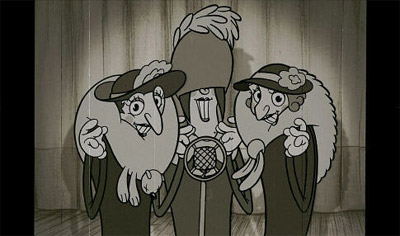
[camarades et amitié]
Matthieu Chedid -- Belleville Rendez-Vous (French Version)
Kraftwerk -- Tour de France (French Version)
A young boy grows up to become a cyclist whom the French mafia want to kidnap to use as a power source. Yes. This is a common problem.
A few points about the French mafia:
1. They are better-dressed than the American mafia.
2. They are less interested in practicality than in the je ne sais quoi of an idea.
3. They tend to be broad and squarish and so thin they nearly disappear when they turn to the side. For this reason, they could be lurking anywhere.
Childhood events exercise a curious power over the mind (whether human or canine). Yes. They are called "formative years" for a reason.
A few points about The Triplets of Belleville:
1. It's quirky (you guessed that).
2. It's visually innovative.
3. It has sparse dialogue.
Benoit Charest writes, and Matthieu Chedid sings,* warm organic music with real instruments. Kraftwerk makes cold computerized music with circuits and knobs and switches.
A few points about Belleville Rendez-Vous (French Version):
1. acoustic guitar, muted strums.
2. classical guitar with the fingers breakdancing down the frets.
3. the voice. the voices. the harmony.
A few points about Tour de France (French Version):
1. drum machines, bike chain, grunts of a cyclist up a long hill.
2. the guitar, sounding like steel drums, with an unlikely melody.
3. the harp suggesting that might be the warmest Kraftwerk get.
[Triplets of Belleville]
[I think the French version is the same as the Francois K. remix on this disc but I'm not sure, as I only have the LP EP.]
...
If you don't read Girish's site you probably missed the notice, and even if you do read it, you might have forgotten about it, but I'm calling for a horror film blogathon on October 31st. (And today is a bit late to make the announcement, yes; suffice it to say that organizing movements is not one of my strong points.)
The blogathon is an idea Girish cooked up: bloggers write about one topic and all post on the same day; all you have to do to be a part of it is to post on the topic and say you're a part of it. In the past people have written on Showgirls, avant-garde film, Abel Ferrara's films, Hayao Miyazaki's films, Michelle Pfeiffer's films, and Code Unknown. If you decide to take part, please send me the URL once you've posted so I can link to it.
Elsewhere:
Soulheads, don't miss Darcy's post on The Ohio Players, Dan Phillips' post on Bobby Rush, and Soul Sides' post on Johnny Otis.
...
The House Next Door with a Jonathan Rosenbaum interview.
...
Fast Film, an animated movie mashup short. I've seen this before, though I can't remember where.
...
For the sidefills, can we have two great big enormous things please, of a type that might be venerated as gods by the inhabitants of Easter Island, capable of reaching volumes that would make Beelzebub soil his underpants, and driven by amplifiers that could provide the power for a Monster Truck Rally.
Iggy Pop's concert rider
...
Free Hugs: much better with the sound off. I like it with Ernie K-Doe's "Te Ta Te Ta Ta."
...
one-dimensional Tetris.
*Thanks to Vincent for correcting me on the attribution.
Pédaler en grand braquet

[camarades et amitié]
Matthieu Chedid -- Belleville Rendez-Vous (French Version)
Kraftwerk -- Tour de France (French Version)
A young boy grows up to become a cyclist whom the French mafia want to kidnap to use as a power source. Yes. This is a common problem.
A few points about the French mafia:
1. They are better-dressed than the American mafia.
2. They are less interested in practicality than in the je ne sais quoi of an idea.
3. They tend to be broad and squarish and so thin they nearly disappear when they turn to the side. For this reason, they could be lurking anywhere.
Childhood events exercise a curious power over the mind (whether human or canine). Yes. They are called "formative years" for a reason.
A few points about The Triplets of Belleville:
1. It's quirky (you guessed that).
2. It's visually innovative.
3. It has sparse dialogue.
Benoit Charest writes, and Matthieu Chedid sings,* warm organic music with real instruments. Kraftwerk makes cold computerized music with circuits and knobs and switches.
A few points about Belleville Rendez-Vous (French Version):
1. acoustic guitar, muted strums.
2. classical guitar with the fingers breakdancing down the frets.
3. the voice. the voices. the harmony.
A few points about Tour de France (French Version):
1. drum machines, bike chain, grunts of a cyclist up a long hill.
2. the guitar, sounding like steel drums, with an unlikely melody.
3. the harp suggesting that might be the warmest Kraftwerk get.
[Triplets of Belleville]
[I think the French version is the same as the Francois K. remix on this disc but I'm not sure, as I only have the LP EP.]
...
If you don't read Girish's site you probably missed the notice, and even if you do read it, you might have forgotten about it, but I'm calling for a horror film blogathon on October 31st. (And today is a bit late to make the announcement, yes; suffice it to say that organizing movements is not one of my strong points.)
The blogathon is an idea Girish cooked up: bloggers write about one topic and all post on the same day; all you have to do to be a part of it is to post on the topic and say you're a part of it. In the past people have written on Showgirls, avant-garde film, Abel Ferrara's films, Hayao Miyazaki's films, Michelle Pfeiffer's films, and Code Unknown. If you decide to take part, please send me the URL once you've posted so I can link to it.
Elsewhere:
Soulheads, don't miss Darcy's post on The Ohio Players, Dan Phillips' post on Bobby Rush, and Soul Sides' post on Johnny Otis.
...
The House Next Door with a Jonathan Rosenbaum interview.
...
Fast Film, an animated movie mashup short. I've seen this before, though I can't remember where.
...
For the sidefills, can we have two great big enormous things please, of a type that might be venerated as gods by the inhabitants of Easter Island, capable of reaching volumes that would make Beelzebub soil his underpants, and driven by amplifiers that could provide the power for a Monster Truck Rally.
Iggy Pop's concert rider
...
Free Hugs: much better with the sound off. I like it with Ernie K-Doe's "Te Ta Te Ta Ta."
...
one-dimensional Tetris.
*Thanks to Vincent for correcting me on the attribution.
Labels: blogathon, electronica, soundtrack
Friday, May 12, 2006:
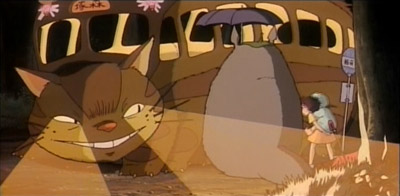
Stray Cats -- Rock This Town
The Stray Cats formed in New York in the late 1970s and had some success spearheading a rockabilly revival during the New Wave period, though their early album Built for Speed sold the best and their popularity tapered off afterwards. Their guitarist was Brian Setzer, whom you'll probably remember from the swing revival some time back; the man loves his roots music. I haven't heard most of his solo music, and I bought this LP on a lark (actually not true--I've never done anything on a lark, though I used to dine on a turkey), wondering if it could possibly be any good. And I think that it is.
[Stray Cats -- Built for Speed, or a more reasonably priced Greatest Hits comp]
...
In spite of having had plenty of time to prepare for an announced Miyazaki blogathon, my attentions were mostly elsewhere between then and now. So I'll just talk briefly about one of my favorite Miyazaki films, My Neighbor Totoro. It's a story about two girls (Mei and Satsuki) moving to a house near the forest; their father works at a university and their mother is in the hospital being treated for an unidentified illness. Like most of Miyazaki's work, it's got a fairly simple plot but takes some unexpected and wonderful turns: for instance, there are these odd black sooty creatures living in the house, which their father identifies as mak-kuro kurosuke, the spots you see when going from darkness to bright light, and which their elderly neighbor identifies as susu-atari, the creatures that live in old, empty houses and make dust.
On Satsuki's first day at school, Mei discovers an odd ghostly creature moving through the grass. She chases it through a low passage in the trees, almost a tunnel made of interleaved branches, then tumbles through a hole and meets Totoro, the king of the forest. I won't give the whole story away, but I wanted to post the following screenshots to give some idea of what it is I like about Miyazaki. I'm sure they'll explain it much better than I can--this sequence would be magic even if it weren't about a girl lending her father's umbrella to the keeper of the forest.

He has claws, yes. He takes the umbrella carefully, and Satsuki shows him how to use it.
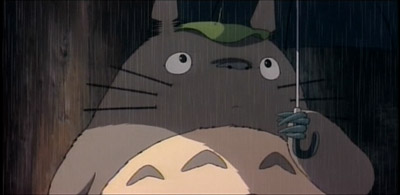
He decides he likes the sound the rain makes on the umbrella:


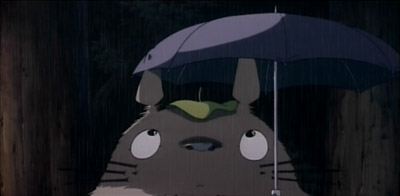

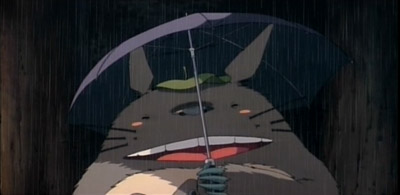
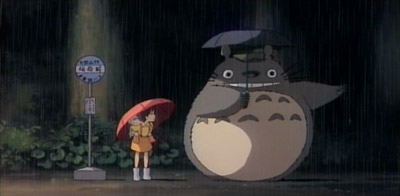



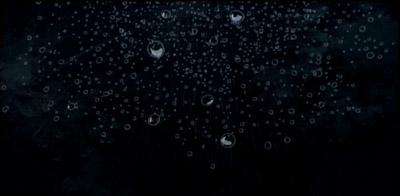
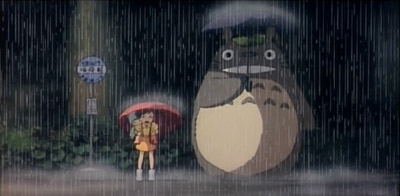
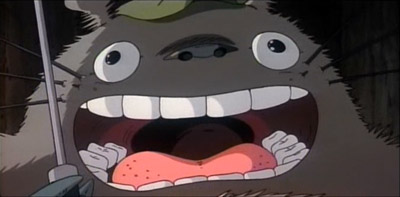
Aside from its quirkiness and its frequent mixture of menace and wide-eyed wonder, Miyazaki's work also shows a loving attention to detail. For instance, in My Neighbor Totoro there are the mice lights on the cat bus (the running lights at top), the dragonflies landing on garden posts, the discarded bottle at the bottom of a stream, the snail crawling up a plant's stalk, and the irises and lilies scattered in the landscape even in brief shots where the attention is directed elsewhere.
It's fun and fascinating work--even his earliest work in television has been worthwhile--and I'm happy that his films are widely available and in their original formats.
[Site dedicated to Hayao Miyazaki's work]
[Interview with Hayao Miyazaki: "It's not me who makes the film. The film makes itself and I have no choice but to follow."]
[Roger Ebert's writeup on Miyazaki and My Neighbor Totoro]
update: Quiet Bubble has writeups for Miyazaki's most recent three films, Princess Mononoke, Spirited Away, and Howl's Moving Castle. The first two are perceptive, but I can't speak to the third--I haven't yet seen the movie so I didn't read it. ^_^
Also see: Noel Vera on Howl's Moving Castle, cinemarati on On Your Mark, and CultureSpace on Spirited Away.
New at Quiet Bubble: writeups on Porco Rosso, Kiki's Delivery Service, Nausicaa, Lapute, and My Neighbor Totoro.
I'll be posting additional links to other posts in the Miyazaki-thon (Miyazaki-san-athon?) as I find them.
...
In other news, I'd like to recommend new mp3blog MadPriest-UK. First post: awesome soul mix. Second: Latin tracks. It's a good start.
Stray Cats and the cat bus

Stray Cats -- Rock This Town
The Stray Cats formed in New York in the late 1970s and had some success spearheading a rockabilly revival during the New Wave period, though their early album Built for Speed sold the best and their popularity tapered off afterwards. Their guitarist was Brian Setzer, whom you'll probably remember from the swing revival some time back; the man loves his roots music. I haven't heard most of his solo music, and I bought this LP on a lark (actually not true--I've never done anything on a lark, though I used to dine on a turkey), wondering if it could possibly be any good. And I think that it is.
[Stray Cats -- Built for Speed, or a more reasonably priced Greatest Hits comp]
...
In spite of having had plenty of time to prepare for an announced Miyazaki blogathon, my attentions were mostly elsewhere between then and now. So I'll just talk briefly about one of my favorite Miyazaki films, My Neighbor Totoro. It's a story about two girls (Mei and Satsuki) moving to a house near the forest; their father works at a university and their mother is in the hospital being treated for an unidentified illness. Like most of Miyazaki's work, it's got a fairly simple plot but takes some unexpected and wonderful turns: for instance, there are these odd black sooty creatures living in the house, which their father identifies as mak-kuro kurosuke, the spots you see when going from darkness to bright light, and which their elderly neighbor identifies as susu-atari, the creatures that live in old, empty houses and make dust.
On Satsuki's first day at school, Mei discovers an odd ghostly creature moving through the grass. She chases it through a low passage in the trees, almost a tunnel made of interleaved branches, then tumbles through a hole and meets Totoro, the king of the forest. I won't give the whole story away, but I wanted to post the following screenshots to give some idea of what it is I like about Miyazaki. I'm sure they'll explain it much better than I can--this sequence would be magic even if it weren't about a girl lending her father's umbrella to the keeper of the forest.

He has claws, yes. He takes the umbrella carefully, and Satsuki shows him how to use it.

He decides he likes the sound the rain makes on the umbrella:












Aside from its quirkiness and its frequent mixture of menace and wide-eyed wonder, Miyazaki's work also shows a loving attention to detail. For instance, in My Neighbor Totoro there are the mice lights on the cat bus (the running lights at top), the dragonflies landing on garden posts, the discarded bottle at the bottom of a stream, the snail crawling up a plant's stalk, and the irises and lilies scattered in the landscape even in brief shots where the attention is directed elsewhere.
It's fun and fascinating work--even his earliest work in television has been worthwhile--and I'm happy that his films are widely available and in their original formats.
[Site dedicated to Hayao Miyazaki's work]
[Interview with Hayao Miyazaki: "It's not me who makes the film. The film makes itself and I have no choice but to follow."]
[Roger Ebert's writeup on Miyazaki and My Neighbor Totoro]
update: Quiet Bubble has writeups for Miyazaki's most recent three films, Princess Mononoke, Spirited Away, and Howl's Moving Castle. The first two are perceptive, but I can't speak to the third--I haven't yet seen the movie so I didn't read it. ^_^
Also see: Noel Vera on Howl's Moving Castle, cinemarati on On Your Mark, and CultureSpace on Spirited Away.
New at Quiet Bubble: writeups on Porco Rosso, Kiki's Delivery Service, Nausicaa, Lapute, and My Neighbor Totoro.
I'll be posting additional links to other posts in the Miyazaki-thon (Miyazaki-san-athon?) as I find them.
...
In other news, I'd like to recommend new mp3blog MadPriest-UK. First post: awesome soul mix. Second: Latin tracks. It's a good start.
